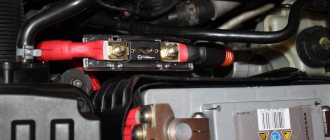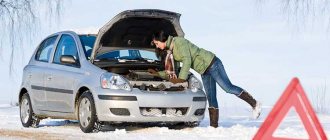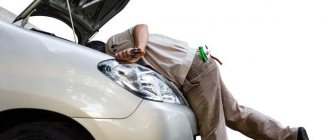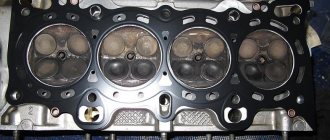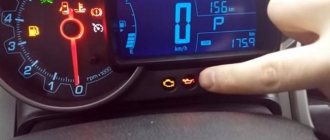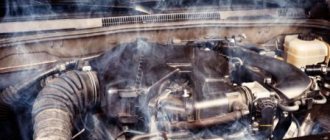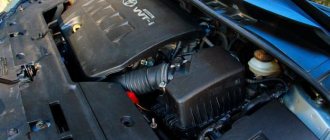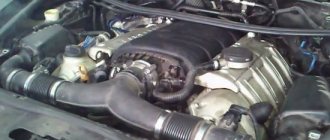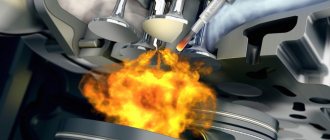Often, problems with starting the engine begin in the autumn-winter season. Then, due to the thickened oil, it is difficult for the starter to turn the crankshaft, and the air-fuel mixture cannot ignite in time in cold chambers. But today we will talk about another case. In practice, any car owner has had situations when the engine did not start when the engine was well warmed up.
Engine overheating: signs, how to avoid and what to do if the engine has already boiled
Hot summer is not only a time for a memorable holiday, but also a season when motorists face many problems.
The main one is engine overheating. You may cancel your planned trip, or you may encounter a more serious problem, the engine will be damaged, which will entail a truly expensive repair.
Several signs that the engine is overheating
There are basic signs that help identify this problem:
- The indicator arrow is in the red zone.
- The temperature of the power unit exceeded 80 degrees.
- Significant reduction in power indicators.
- The overheating warning lamp is the main signal.
- An unpleasant odor suddenly appeared in the cabin.
- When you press the gas pedal, you hear an uncharacteristic ringing sound.
If any of these signs appear, it is best to stop and check the condition of the engine. After all, further movement can lead to breakdown of the power unit.
How to avoid overheating
There are recommendations that will help avoid such unpleasant situations:
- Avoid high speeds, because under such conditions the engine overheats most often.
- Don't skimp on oil or coolant. Do not use water as an alternative to coolant, this will avoid problems.
- Regularly remove dirt from the radiator grille. This contributes to maximum engine cooling.
Get your vehicle checked periodically. Timely troubleshooting helps avoid engine overheating problems.
Overheating has already occurred, what to do next?
If you are faced with a situation where the engine has overheated, do not rush to panic. If you act wisely, you will be able to cope with the problem and continue your trip.
What to do if signs of overheating appear:
- Don't slow down, just open the windows and turn on the heater. Try to drive at low speeds; driving fast will allow the air to quickly cool the power unit.
- If steam is already noticeable, then you should stop, open the hood and let the engine cool. Most often, 10–15 minutes is enough.
- If there are no signs that coolant is leaking, then simply add it to the valve. This will normalize the engine temperature.
Start the power unit after adding coolant. If it doesn't heat up too much again, you can continue your journey.
Source
How to start a diesel engine?
Diesel engines have a different starting system than gasoline engines. Gasoline engines start when the fuel is ignited by a spark from the spark plug. Diesel engines start thanks to the heat generated by compression. In this case, the fuel and air must become hot enough to begin the combustion process, which in turn creates a spark that starts the engine.
Turn the key to its original position without starting the engine
• The standby indicator on the instrument panel will light up. Do not start the engine until the lights are turned off.
Wait for the glow plugs to warm up before starting the car.
• Glow plugs may take up to 15 seconds to heat up - even longer in cold weather. The standby indicator off is used to signal when the glow plugs are hot enough.
Before the start of the cold season, check the glow plugs or fuel heater to avoid starting problems. There are two ways to obtain the heat needed to start the process: glow plugs and a fuel preheater (the latter is used less). A glow plug (glow plug) is a resistance device that heats the air in the system to allow the vehicle to start. Especially in cold weather, diesel vehicles will not start without one of these two assistance systems.
Replace the battery if necessary. Diesel cars have 2 batteries to start the engine and heat the glow plugs, so always keep 2 good spares.
• If it does not start after 30 seconds, turn it off by turning the key to the stop position.
Try starting the car again with the glow plugs properly heated
• Turn the key back to the starting position and wait until the standby indicator goes out.
Connect the car to an electrical outlet. Diesel cars have a 3-pin plug, usually under the front bumper or under the grille. Using an extension cord, plug the car into an outlet. This allows the heater to create the heat needed to start the process.
Leave the car plugged in for at least 2 hours before attempting to restart it. It takes quite a long time for the coolant to heat up in the engine block. If after this procedure it still does not start, contact a diesel mechanic for assistance. If the car is left in a very cold place, try warming up the glow plugs by turning the key to the original position, waiting for the lights to go off, then turning the key to the off position and repeating the process.
Warnings:
Diesel turns into a gel at temperatures from -6 to -18 °C. In this case, the engine will not start because the diesel fuel is frozen. If you are in an area where the temperature is that cold, fill up at a gas station that uses additives that can lower the freezing point of diesel fuel, or buy a special additive yourself.
Never use starting fluids on diesel engines. Starting fluids can only be used with gasoline engines. When used with diesel engines, they can damage the pistons or combustion chamber.
Source
What to do if the engine overheats and does not start
- Registration
- Entrance
- To the beginning of the forum
- Forum Rules
- Old design
- FAQ
- Search
- Users
And so, such a problem.
If you drive the car for a long time, or even not for long at all, for example in the summer, and then turn it off, then it will not start.
What I myself discovered: For example, if the temperature is more than 90 degrees, and then you turn off the car, then it will not start until the temperature drops below 70.
How to treat it: For example, you can disconnect the battery terminals and plug them back in, then in 90% of cases you can start it. But this is definitely not related to the battery, the problem is precisely the temperature above 90, because... Now the cold weather has arrived and this problem has simply disappeared, everything starts the first time.
They changed the starter generator, but it didn't help. Generally a strange problem. VAZ 2112 16 valve car.
Maybe someone had this.
Yes, all summer because it was like this, and so I decided to check if it would be in the winter. And everything is gone, we really need to fix it.
it won’t start in the following way, for example, I insert the key -> I turn it a little -> And then I start it, and the starter doesn’t turn any reaction, the indicator lights go out a little, well, it’s as if something is shorted out and that’s it. And so on until the car cools down.
This happened to me when I didn’t tighten the corrugation after the DMV. until it warms up, either according to the table, or according to the DMRV, it stalls immediately.
Well, for you it starts and stalls, but for me it doesn’t even start at all, you just turn the key to nothing, turn it and there’s 0 reaction..
it won’t start in the following way, for example, I insert the key -> I turn it a little -> And then I start it, and the starter doesn’t turn any reaction, the indicator lights go out a little, well, it’s as if something is shorted out and that’s it. And so on until the car cools down.
And learn to clearly formulate the task. “Won’t start” means you turn the starter, but it doesn’t start. And your starter just won't turn over when it's hot. There it doesn't even get to the point of starting up. OK ?
Well, of course, I’m just a newbie, and now I’ll sit on the forum to figure it all out.
Yes, that’s right, the starter doesn’t turn when it’s hot, but it happens that the car starts when the temperature is above 90. It just doesn’t start, for example in the summer, after the fans work, for example, I stopped at a gas station, stood there waiting for maybe 5 or 10 minutes, the fans went off, and turned it off, that's it. Then you push the car for about 10 meters and wait until it cools down, or try to remove the battery terminals, which I said helps in 90% of cases, but sometimes in 10% we don’t help.
For example, I drove around the city at +30 for an hour and if I turned it off, I had to remove the terminals again and it was very infuriating. Right now I hope this topic will help solve what the problem is. I think I'm not the only one.
Checking the electrical components of the car.
First of all, open the hood and check the battery terminals and the battery itself. We see that the terminals are well screwed, not oxidized, and there are no broken wires. It is advisable to check the voltage of the battery itself. If everything is in order, then check the battery charging. How to do this is described in detail in THIS article. Most often, a car stops showing signs of life precisely because of a dead battery. You can try to light the car, you can do this by asking someone on the road for help.
Car won't start? try to light a cigarette.
Be careful. If the car smells burning, it means there is a short circuit somewhere. In this case, it is necessary to very quickly remove the battery terminals. Be sure to wear gloves before this procedure. During a short circuit, the terminals become very hot. In the event of a short circuit, connect the terminals only after eliminating the cause, otherwise there is a risk of fire.
If everything is in order with the battery and charging, then check the fuses. They are most often located under the front panel and under the hood of the car. We take out each one in turn and check its safety.
If the corresponding lights on the instrument panel come on when the ignition is turned on, but the starter does not fire when you turn the key, then the starter itself, the wiring, or the ignition switch is to blame. It's not that hard to check either. You need to find the wire coming from the starter (the thinnest one) and apply voltage to it from the + terminal of the battery. Do not forget to remove the car from speed. When power is applied to the wire, the starter should operate. If this does not happen, then the starter should be removed and repaired. Read more about starter malfunctions and how to check the starter without removing it from the car in THIS article.
Starter wire
Won't start after overheating
In general, briefly about the situation, I was driving from Moscow to St. Petersburg, 200 km from home the drive belt broke, naturally the battery does not charge, there is no power steering, and the worst thing is that the pump does not turn the coolant, in the end, with grief, I was able to drive 50 km, until the smoke came into the cabin and a cloud of white smoke also came out of the hood (in theory it was steam), semi-thick antifreeze flowed from under the antifreeze cap, when I tried to start it, it wouldn’t start, so I arrived in St. Petersburg on a tow truck.
What is the problem and what did I change? It turns out that the drive belt (the third one in a week broke due to a crooked tensioner pulley) changed all this, also filled in new antifreeze, etc. The car won't start, everything is spinning, it's about to grab, but nothing else. I noticed that the hot antifreeze was burned under the cap where the antifreeze “tee” is poured in, and when the plant pours a little antifreeze out of it, it may not start because air gets into the system, although a mechanic I know said that it would have started anyway.
In general, who can tell me at least approximately what could have happened so that I would pay attention to this in the first place. I will be grateful for your answers.
The car is almost 3 years old, 118,000 miles
Question:
Why doesn't the engine start after overheating?
Answer:
One of the reasons for such a malfunction in old-generation domestic cars (we are talking about Russian automobile classics - Volgas, Ladas and Moskviches) is that the fuel pump, responsible for supplying fuel to the carburetor, was simply tightened directly on the engine body . And this device is quite thin.
The engine is overheated - reasons
Why do engines boil is a question that interests many car enthusiasts. After all, no one wants to be in the middle of the street with a car with a column of steam literally pouring out from under the hood. Among the most common reasons, experts name the following options:
- Thermostat malfunction
- Pump problems
- Leakage of fluid responsible for cooling the engine
- The appearance of air plugs in the system
- Fan doesn't work
In each specific case, correction of the situation and various types of repair work will be required.
Thermostat is faulty
When the thermostat gets stuck opening, difficulties and interruptions begin. The liquid responsible for cooling in the car passes only to circulation in a small circle - it is also called a cooling jacket, bypassing the radiator. And this failure cannot be noticed externally.
Some signs that the thermostat is no longer working at full capacity include:
- The engine slowly warms up to a temperature called operating temperature.
- The lower radiator hose begins to heat up quickly - in just a couple of minutes even after a cold start
- When accelerating, the arrow of the temperature sensor first falls, and when stopping or idling it rises
It is worth taking a close look at the behavior of your car to sense a malfunction.
Pump faulty
If the pump fails, the liquid ceases to be properly pumped through the cooling system. Problems with pump operation may occur due to:
- Wear parts
- Impeller destruction
- Drive problem
It is worth understanding that the pump has a certain resource, after which it may well break. Experts estimate the lifespan of the pump at 80-100 thousand km. And this parameter is even included in the maintenance regulations.
Diesel engines
If the diesel engine does not start when hot, then the fault should be looked for in the fuel injection pump. Most often, the breakdown is simple and trivial - the oil seals and bushings have failed. The problem can be solved by servicing the pump. But the reason for the non-start may also be in the plunger pair - to solve this problem, a major overhaul of the pump is required.
The same problems are observed in the case of a faulty OPTS. To remove the plunger, the fuel injection pump from the rear is cooled, and then attempts are made to start the car. If the car starts, then the plunger pair is to blame.
If the car does not start when hot, the reason may be worn out oil seals, as well as the bushings of the injection pump drive shaft. There is a place under the seal from which the pump sucks air. This does not allow creating the required pressure in the plunger chamber. To treat and improve the situation, replace the oil seals and bushings.
How to make a hot engine start well
To do this, it is necessary to lean the fuel mixture to normal. When starting a hot engine, depress the gas pedal halfway. Sometimes it even happens that it is necessary to depress the pedal completely. If you press and release the pedal several times, you may not improve, but, on the contrary, worsen the situation. The pump will send more and more fuel mixture, which will further enrich the mixture. In this case, starting the engine will be very problematic.
Novice drivers, having driven a car, begin to understand it better, and then such problems do not arise. After starting the engine, with a few presses on the accelerator, the car will move off without any problems.
That's pretty much all that can be said about this problem. If it doesn’t start when hot, there may be other reasons, but you now know the main sources and can diagnose your car yourself.
Source
Overheated and now won't start
sandro » Sep 13, 2011, 00:22 » Message No. 167427
I was driving home from work and all the antifreeze was knocked out of the expansion tank, either in the air plug or in the gasket under the head of the block. The car overheated and I stopped to let it cool down and then it didn’t start at all!
Yuri. » 13 Sep 2011, 12:44 » Message No. 167444
The block gasket and the air plug have nothing to do with it, in general, the plug doesn’t matter, it won’t happen like that. The lid could simply not work, the lid works like a valve. The thermostat malfunctioned or the pump specifically broke (this is true, but not the gasket). How does it not start? What are the symptoms?
Added after 2 minutes 37 seconds: It happens that when there is overheating, when the oil does not flow, the crankshaft jams. (You didn’t describe how it won’t start. Does the starter spin, does the crankshaft rotate, spark, etc..)
StavraS » Sep 14, 2011, 09:23 » Message No. 167481
I also warmed up fine yesterday. but my thermostat just didn't work. generally deaf. and more than once. But what was there to do? It was a traffic jam. It stalled but started on the 5th or 6th attempt. As soon as I got home, the engine was already refusing to pick up any speed. in general, the temperature was, offhand, at least 110-120 degrees. And so I drove for 50 kilometers, stopping for 20 minutes. When I arrived home, I poured hot, then warm, and cold water over the engine. cooled down, changed the thermostat, started it and everything was ok. The traction did not disappear, the compression was measured immediately. compression is normal. But there is one thing. The pump began to run due to pressure. Now I’m disassembling the engine. The rest is normal. All that remains is to wait...whether the oil will be eaten. Honestly, I was surprised that it started up hot, drove, and didn’t change the compression.
Yuri. » 15 Sep 2011, 11:18 » Message No. 167518
What are your fans for? When my temperature rose, the fans immediately brought it down.
StavraS » Sep 16, 2011, 09:35 » Message No. 167657
The fact of the matter is that the fans worked incessantly.
Yuri. » 16 Sep 2011, 11:10 » Message No. 167662
This means the thermostat was not allowing circulation.
sandro » Sep 16, 2011, 09:21 pm » Message No. 167683
Injection cars
The carburetor is a more primitive device, and the reasons for its problems are simple. And you have to tinker with the injection power system much longer. There are other reasons here. If the injector does not start when hot, there are many reasons for this.
Experts first recommend checking the operation of the coolant temperature sensor. Due to a malfunction, it sends incorrect data to the ECU. This disrupts the fuel supply algorithms. Accordingly, the mixture becomes poorer.
Next, another popular place is the injectors. Often, due to defective injection, the engine will not start or starts with difficulty. To check the injectors, they are dismantled and then tested on a specialized stand.
Spark plug
Spark plugs are a very important element in a car, especially when starting.
Did you know that spark plugs need to be changed according to technical regulations, which are written in your service book and in the operating manual of your car? Did you forget to do this? Okay, the most common problem is spark plugs filled with gasoline. When you try to start your car many times and nothing works, but you keep trying. This is how inexperienced drivers fill spark plugs, and if they are filled, there will definitely be no spark.
Checking the battery and wiring
The most common cause of problematic engine starting on Sanyeng Chiron is considered to be a weak charge in the electrical circuit, the causes of which may be:
- Low battery charge - a low-grade analogue of the original battery or the habit of frequently using additional car functions when powered by ACC can become another factor for the headaches of many drivers;
- Weak contact in the power wiring - it is necessary to inspect the wires for breaks or rotten sections in the circuit, as well as eliminate traces of metal oxidation on the battery terminals;
- Failure of fuses - on a car of this model, the fuse is often located under the steering control unit, and the other part is near the engine on the right side. First of all, it is necessary to inspect the fuses responsible for the primary electrical systems of the engine.
Note! It is not advisable to save on the electrical parts of the vehicle. Using budget components or neglecting timely troubleshooting can cause a short circuit, which will negatively affect both the service life of the vehicle and the cost of future maintenance.
Tips and tricks
As you can see, if the car does not start after washing the engine, there can be quite a lot of reasons, ranging from the most obvious to a breakdown, which is quite difficult to determine on the spot.
On different cars, water may get inside parts, which leads to their failure after a short circuit. In this case, drying the engine and engine compartment is useless, since damaged elements require replacement or repair to start the internal combustion engine.
During initial diagnostics, it should be taken into account that the ignition system most often suffers from water ingress. For this reason, the initial inspection should begin with the elements of the specified system. If the driver has noticed that the car has previously been difficult to start in wet weather or after washing the body, then this may indicate that somewhere there is a breakdown in the insulation of armored wires, a crack in the distributor cover, etc.
Please note that if the engine has been washed, then it is necessary to check the engine compartment for moisture accumulation before the engine is started for the first time. In other words, it is better to dry the engine immediately after washing, before starting the unit
This will avoid problems such as burnt ignition coils, short circuits, etc.
We also note that if the culprit of a difficult start is a gray coating on the battery terminals, then after disconnecting the terminals from the battery, this coating dissolves well and is removed with ordinary water. It is enough to pour water onto the terminal and then dry it, instead of taking a long time to remove the deposits with brushes or sandpaper.
Consequences of engine overheating
Mild and short-term overheating usually has no consequences for the engine. In principle, it can occur at any time in the summer heat, when the car is either driving very fast, or, conversely, very slowly “dragging” uphill in a city traffic jam in a low gear. It is enough to stop, let the engine cool, check the coolant level, top up if necessary (you can just use clean water), and then carefully move towards the nearest service station.
Average overheating (usually no more than 10-20 minutes) already entails serious consequences, which may result in detonation, vibration, knocking and loss of power. This means that the engine needs to be repaired from medium to major. And it is better to tow such a car to a service station.
Severe overheating usually ends in disaster for the engine and cooling system.
What's the result?
If you maintain the vehicle in a timely manner, then there should be no serious problems with starting the engine - any malfunction can be easily corrected on the spot on your own. You can also further protect yourself from problematic engine starting by installing high-quality components - replicas or analogues do not always meet the needs of the car.
However, in the event of a serious breakdown, it is recommended to go to a service station for help - the engine is a complex structural system, the unstable operation of which can cause expensive repairs in the near future.
Checking the air filter
Often, a problem with starting an engine is the appearance of a blockage in the air transport system, which prevents the full formation of the air-fuel mixture for the power unit.
As a rule, drivers on Sanyeng Kyron often forget to replace the air filter, which leads to a decrease in air supply to the fuel system. The service life of the air filter on the Kyron is 20,000 km, after which it is recommended to replace the component. However, in practice, it is advisable to change the air filter every trip on a dusty road - operating a vehicle in rural areas or on unpaved roads quickly leads to clogging of the filtration system.
Note! It is strictly not recommended to install a zero-resistance air filter on the Kyron in order to increase the power potential of the engine. There is no practical value from such tuning, however, reducing the filter base makes it easier for small abrasive particles to access the engine chambers, shortening the service life of the power plant. Sanyeng Kairon has a negative reaction to such tuning.
Analyzing the condition of the engine
Problem starting a vehicle may be due to an overheated power unit. Engine overheating is diagnosed by a temperature sensor - if the indicator exceeds the working zone of the motor and the dynamics drop, then the engine is under critical load and may overheat. If the power unit is steamed, you must wait until the installation has completely cooled down - otherwise the starter may fail.
After successful ignition of the power unit, it is recommended to go to a service station as soon as possible for diagnostics in order to determine possible damage. Also, an overheated engine should not be subjected to dynamic loads, otherwise the situation may worsen.
It is important to know! The design of the car extremely negatively tolerates overheating of the power unit. Due to the nearby location of important electrical components, boiling of the engine can lead to melting and short-circuiting of the power wiring, which will further aggravate the situation and increase the cost of car repairs.
Why does a warm engine stall?
Some motorists are faced with a situation where an already running and warmed-up engine suddenly stalls. Moreover, this happens after the sensor has recorded a set of normal operating temperatures. There may be several reasons for this. Next, we will consider them in more detail, and also indicate what needs to be done in this or that case.
- Poor quality fuel. This situation is typical, for example, if you are driving away from a gas station, and after a short period of time the engine begins to “cough”, the car jerks and stalls. The solution here is obvious - drain the low-quality fuel, bleed the fuel system and replace the fuel filter. It is also advisable to replace the spark plugs, but if they are new, you can get by by blowing them out. Naturally, you shouldn’t go to such a gas station in the future, but if you have saved your receipt, you can go there and make a claim about the quality of the fuel.
- Fuel filter. If the engine stalls, you should also check the condition of the fuel filter. And if according to the regulations it is already necessary to replace it, then this must be done, regardless of whether it is clogged or not yet.
- Air filter. The situation is similar here. The engine may “choke” on the rich mixture and stall shortly after starting. Check its condition and replace if necessary. By the way, this way you can also reduce fuel consumption.
- Gasoline pump. If it does not operate at full capacity, the engine will not receive enough fuel and, accordingly, will stall after a while.
- Generator. If it completely or partially fails, it stops charging the battery. The driver may not immediately notice this fact, start the engine and drive away. However, it will only drive until the battery is completely discharged. Unfortunately, it will no longer be possible to start the engine on it again. In some cases, you can try to tighten the alternator belt. If this procedure does not help, you need to call a tow truck or call your friends to have your car dragged to a garage or service station.
Try to monitor the normal condition of the components and mechanisms listed above. Even minor breakdowns, if not corrected in time, can develop into big problems that will result in costly and complex repairs for you.
Conclusion
The first thing you need to do to ensure that the engine starts normally when hot is to refuel at proven gas stations, and also monitor the condition of your car’s fuel system. If, after even a short stay in the heat, the engine does not start, then first open the throttle valve (press the accelerator pedal) or remove the filter cover and leave it open for a couple of minutes. During this time, the evaporated gasoline will evaporate and you will be able to start the engine normally. If this procedure does not help, then it is necessary to troubleshoot among the components and mechanisms described above.
Source
Gasoline pump
If the VAZ does not start when hot (especially if it is an old car), then, among other things, it may be that the fuel pump is too hot. This device is cooled by pumping cold gasoline from the tank. But when it's hot outside, gasoline can't be cold. As a result, the pump overheats, making starting difficult. In some cases, it is completely impossible to start the engine. This problem can be corrected by applying a wet cloth to the pump body and periodically cooling it with water. They open the hood, place the car in the shade, and allow the engine and all other components to cool normally. You can just wait until the temperature returns to normal. It is also worth remembering that if the pump has already been overheated, then it will no longer work normally.
Source
Monitoring the engine temperature
Most cars still have a full engine temperature gauge on the dashboard. Unfortunately, on some new models they have begun to replace it with warning lights: blue warns of a cold engine, yellow or red warns of too hot one. It’s not very convenient to navigate them, but you don’t have to choose.
The pointer indicators have also been simplified - specific temperature values have not been shown on them for a long time. The average risk of the scale corresponds to a temperature of ~86 °C and is a normal operating mode. Everything after it in the direction of the letter H (Hot, “hot”) is overheating. The red line next to the “H” corresponds to a temperature of about 130 °C, when the antifreeze is already boiling.
Pay attention to the temperature gauge, especially in difficult conditions for the engine: in summer traffic jams, on long climbs, off-road. If the temperature needle has crossed the middle of the scale, urgent measures must be taken.
